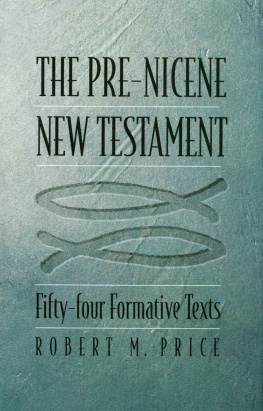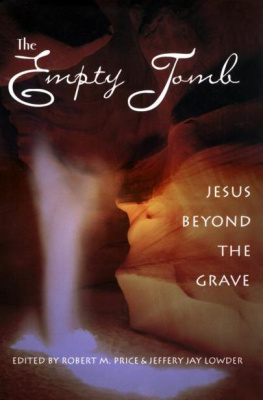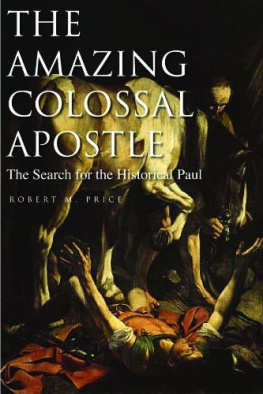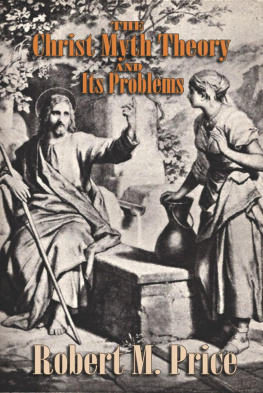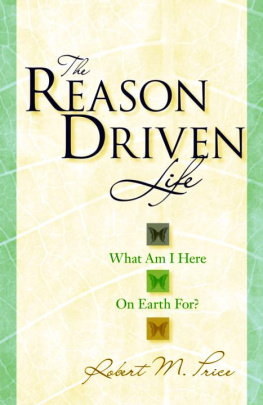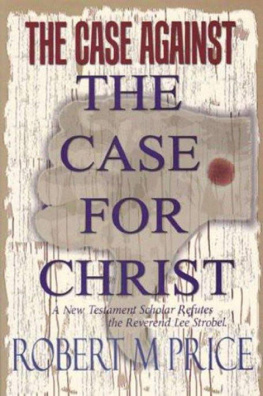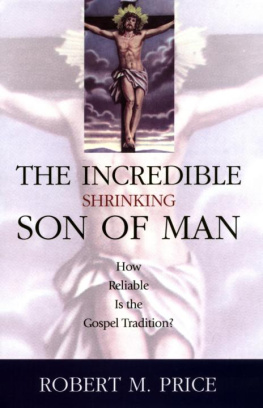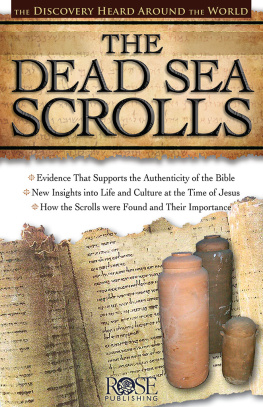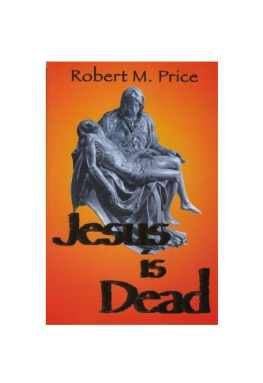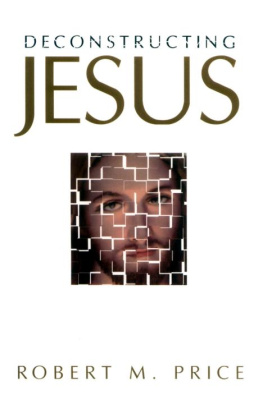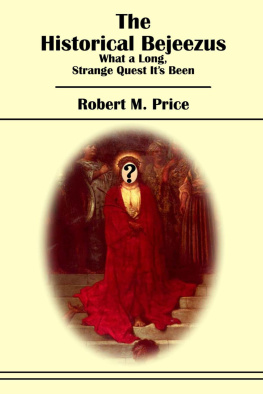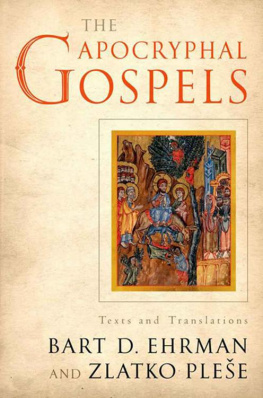The Pre-Nicene New Testament
Fifty-four Formative Texts
Robert M. Price
Signature Books Salt Lake City 2006
For Professor David M. Scholer, who first sent me swimming in the ocean of church fathers, martyrs, heretics, and apocrypha. When he threw me a life preserver, it wasnt his fault that I didnt grab it!
Copyright 2006 Signature Books. All rights reserved. Signature Books is a registered trademark of Signature Books Publishing, LLC.
www.signaturebooks.com
Jacket design by Ron Stucki
Library of Congress Cataloging-in-Publication Data
The pre-Nicene New Testament: fifty-four formative texts / by Robert M. Price.
p. cm.
Includes bibliographical references and index.
ISBN 10: 1-56085-194-5
ISBN 13: 978-1-56085-194-3
1. Apocryphal books (New Testament) I. Price, Robert M., 1954- II. Bible. N.T. English. Price. 2006.
BS2832.P75 2006
229.9205209dc22
2006045036
Contents
Introduction to the Canon
History, Text, and Interpretation
Fruit as well as root
The question of the New Testament canon, which is to say the official list of writings or table of contents, is a vitally important one, as all recognize, and even more important than many realize. On the one hand, if one regards the Bible as inspired and authoritative scripture, it is obviously a vital matter to get clear about which writings are to wield authority over belief and conscience and which shall not. Believing in scripture in general means nothing: it is a matter of specific claims, commandments, doctrines, and rites, and some appear in some documents, others in other documents. For this reason, Protestants follow Martin Luther in rejecting both the book of 2 Maccabees and the practice of praying for the dead, which is endorsed in it. They are ready to believe in the bodily assumption of Elijah into heaven since this event is recounted in 2 Kings, but they scoff at the bodily ascension of the Virgin Mary since this very similar belief is recounted only in non-canonical writings such as The Falling Asleep of the Holy Mother of God. Similarly, biblicists opposing abortion would have a much simpler case to make had the Epistle of Barnabas or the Apocalypse of Peter been admitted into the canon, as they explicitly condemn abortion, whereas the practice does not come up for mention in any document considered canonical.
A more crucial aspect still is that of the authority underlying the Bible. If the texts of scripture authorize everything else in Christian belief and practice, what is it that authenticates the biblical canon? It is not as if the Bible were delivered from the hand of an angel like the Book of Mormon or dictated by an angel like the Koran. The Bible, as everyone knows, is a compilation of many short writings, many of them the products of several writers, redactors, revisers, and scribes. In addition, there were books of the same type that did not finally make it into the canonical list. Who decided on the list and how did they decide? The Bible is not only the beginning of one theological process but is itself the end of another. It is worth looking back at how came the Bible, as Edgar J. Goodspeed used to say. When we have done that, we will be in a position to re-evaluate other books that were not canonized.
Marcionite invasion
The history of a distinctively Christian scriptural canon begins with Marcion of Pontus in Asia Minor. Traditionally dated about 140 AD/CE, Marcion actually may have begun his public ministry earlier, just after the turn of the century. One ancient tradition makes Marcion the amanuensis (secretary) of the evangelist John at the end of the first century. That is probably not historically true, but no one would have told the story if they had not assumed Marcion was living at that time. It was a general tendency of early Catholic apologists to late-date the so-called heretics to distance them from the apostolic period in the same way apologists today prefer the earliest possible date for the epistles and gospels.
Marcion was the first Paulinist we know of. It would later be a matter of some embarrassment to the church fathers that the earliest readers and devotees of the Pauline epistles were the Marcionites and the Valentinian Gnostics. We know of no Paulinists before these second-century Christians. The mid-first century existence of Pauline Christianity is simply an inference, admittedly a natural one, from taking the authorship and implied dates of the Pauline epistles at face value as works representing a wing of first-century Christianity. But it is quite possible that the Pauline literature is the product of Marcionite and Gnostic movements in the late first and early second centuries. Even if most of the Pauline epistles are genuinely from the first century, the most likely candidate for the first collector of the corpus remains Marcion. No one else in the relevant time period would have had either the interest or the opportunity. No one was as interested in Paul as Marcion. Why?
It was because he shared with his theological cousins, the Gnostics, the belief that the true God and Father of Jesus Christ was not the same deity as the creator and law-giver God of Israel and of the Jewish scriptures. In this belief Marcion was perhaps influenced by Zoroastrian Zurvanism, a dualistic doctrine, as Jan Koester suggests. Marcion allowed that the creator God was righteous and just but also harsh and retributive. His seeming grace was but a function of his arbitrariness: Nero might render a verdict of thumbs-up or thumbs-down as the whim moved him, and so with the God of Israel. Marcion deemed the Jewish scriptures historically true and expected messianic prophecies to be fulfilled by a Davidic king who would restore Jewish sovereignty. But Marcion deemed all of this strictly irrelevant to the new religion of Christianity. In his view, which he claimed to have derived from Pauls epistles, Jesus Christ was the son and revealer of an alien God who had not created the world, had not given the Torah to Moses, and would not judge mankind. The Father of Jesus Christ was a God of perfect love and righteousness who would punish no one. Through Jesus, and by extension Paul, the Christian God offered humans the opportunity to be adopted as his children. If they were gentiles, this meant a break with paganism. If they were Jews, it entailed a break from Judaism and the Torah. Marcion preached a strict morality. All sex was sinful. Begetting children only produced more souls to live in bondage to the creator. Marcion believed Jesus had no physical birth but had appeared out of heaven one day in a body that seemed to be that of a thirty-year-old, complete with a misleading belly button, although not human at all: rather a celestial being. Jesus taught and was later crucified. His twelve disciples were to spread his gospel of an alien God and his adoption of all who would come to him. But things went awry: the disciples, as thick-headed and prone to misunderstanding as they appear in the Gospel of Mark, underestimated the discontinuity of Jesus new revelation with their hereditary Judaism, thereby combining the two. This was the origin of the Judaizing heresy with which Paul deals in Galatians and elsewhere.
Marcion had noticed an oddity most Christians never notice as they read the New Testament: if Jesus had named the Twelve to succeed him and seemed satisfied with them, why was there a need for Paul at all? And why should he come to eclipse the others in importance? The Twelve are, for the most part, merely a list of names. By contrast, Paul wrote letters that formed the basis of much of the churchs theology. Marcion saw a simple answer: the risen Jesus saw how far off the track his disciples would go and decided to recruit another who would get the message straight. This was Paul. To invoke a recurrent pattern in Christian history, think of Martin Luther, Alexander Campbell, John Nelson Darby, Joseph Smith, Charles Taze Russell, Victor Paul Wierwille, and others. All these believed that original, apostolic Christianity was corrupted by an admixture of human tradition, and they believed they had a new vision of the outlines of the original, true Christianity and could restore it. This is what Marcion thought already in the early second century. It should not sound that strange to us. Like these later men, Marcion would succeed very well in launching a new church, one that would spread like wildfire all over and even beyond the Roman Empire. Most noteworthy is the fact that the New Testament was his idea.
Next page
